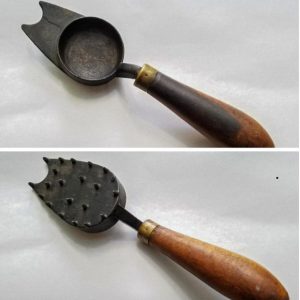The citrus peeler, a simple yet indispensable tool, has a fascinating history rooted in the kitchens of the 19th century. As citrus fruits grew in popularity, so too did the demand for an efficient way to peel them. Today, this handy tool is found in homes and restaurants worldwide. In this article, we’ll explore the history, evolution, and continued relevance of the citrus peeler, showing why it remains a must-have in the modern kitchen.
The Origins of the Citrus Peeler

The story of the citrus peeler dates back to the late 1800s when citrus fruits such as oranges and lemons became more accessible to the general public. Early peelers were often made from metal and featured sharp blades or hooks designed to penetrate and slice through thick rinds. These early versions were utilitarian but effective, allowing people to enjoy citrus fruits without the mess of sticky hands and damaged fruit.
As more people embraced citrus fruits for their flavor and health benefits, the need for a dedicated tool became apparent. The citrus peeler was born out of this necessity, providing a quick and convenient way to remove rinds without damaging the juicy flesh inside.
The Rise of Modern Citrus Peelers
By the mid-20th century, the design of citrus peelers had evolved significantly. With advancements in materials and manufacturing, companies like Tupperware began producing plastic peelers, which were not only durable but also lightweight and easy to use. This marked a shift from the heavier, metal designs of the past.
These peelers often featured ergonomic designs with curved handles that made them comfortable to hold, even during extended use. The innovation of this era reflected the broader trend toward user-friendly kitchen gadgets, designed with both functionality and aesthetics in mind. Brightly colored, streamlined citrus peelers became a staple in post-war kitchens, mirroring the optimism and modernism of the time.
How Citrus Peelers Work
At their core, citrus peelers are designed to perform one simple task: to remove the rind of a citrus fruit without damaging the delicate flesh inside. Traditional peelers typically feature a pointed end or blade that scores the skin, allowing it to be peeled away in sections. This process ensures that the fruit remains intact and ready for eating, zesting, or cooking.
Some peelers also include a spoon-like end that helps lift the peel away from the fruit, making it easier to handle. These dual-purpose designs allow for versatility, as they can be used not only on oranges but also on lemons, grapefruits, and other citrus fruits.
Beyond Peeling: Versatility in the Kitchen

While the primary use of a citrus peeler is to remove the skin of citrus fruits, modern versions of this tool have expanded their utility. Many chefs and home cooks use peelers to create garnishes, removing the rind in long, decorative strips that can add a professional touch to drinks and desserts. Additionally, citrus peelers can be used to zest citrus fruits, providing aromatic and flavorful additions to a variety of dishes.
In some cases, these peelers are even used for non-citrus fruits and vegetables. Their sharp, precise design makes them suitable for peeling produce with tough or waxy skins, such as avocados, cucumbers, and even root vegetables. This versatility has ensured that the citrus peeler remains a popular kitchen tool.
The Legacy of Vintage Citrus Peelers

Vintage citrus peelers, particularly those made during the mid-20th century, have become highly collectible items. These peelers are prized not only for their functionality but also for their design, representing a period when kitchen tools were crafted to last. Collectors appreciate the nostalgia and craftsmanship that these vintage peelers embody, often seeking out original models from brands like Tupperware.
The timelessness of vintage peelers lies in their simplicity and practicality. Unlike many modern gadgets that focus on multi-functionality and advanced technology, these tools were designed with a singular purpose in mind—and they performed that task exceptionally well. Their durable materials and thoughtful design ensure that many vintage peelers still function as effectively today as they did decades ago.
The Modern Citrus Peeler: A Staple in Today’s Kitchen
Despite advancements in kitchen technology, the basic design of the citrus peeler has remained largely unchanged. The reason for this is simple: the tool works. In a world filled with high-tech kitchen gadgets, the classic citrus peeler continues to hold its own, proving that well-designed tools never go out of style.
Today’s citrus peelers are often made from materials like plastic, silicone, or stainless steel, offering a range of options for consumers. Some modern versions incorporate additional features, such as built-in zesting tools or peelers that can be adjusted for different fruit sizes. However, at their core, they still perform the same function that their vintage predecessors did so well.
For many, the citrus peeler is a go-to tool not only for preparing fruit but also for adding that extra touch to a dish, drink, or dessert. Its presence in kitchens around the world is a testament to its enduring utility and timeless appeal.
The Enduring Appeal of the Citrus Peeler

The citrus peeler may seem like a small, inconspicuous tool, but its history and lasting utility make it a beloved part of culinary tradition. Whether you’re peeling an orange for a snack or zesting a lemon for a recipe, the citrus peeler is a reliable companion in the kitchen. Its design may have evolved over time, but its function remains as important as ever.
Vintage citrus peelers, in particular, offer a glimpse into a time when kitchen gadgets were built to last—both in terms of durability and style. Collectors and home cooks alike continue to cherish these classic tools, ensuring that the legacy of the citrus peeler lives on.
In a world where kitchen tools often come and go with the latest trends, the citrus peeler stands as a reminder of the power of simplicity. From its humble beginnings in the 19th century to its iconic mid-20th century designs, this tool has earned its place in the hearts of both professional chefs and home cooks.
So, the next time you reach for your citrus peeler, take a moment to appreciate its rich history and timeless functionality. It’s more than just a tool—it’s a piece of culinary heritage that continues to enhance kitchens around the world, one peel at a time.


